Ferrari Berlinetta Boxer:The Road and Race Legends by Nathan Beehl. Published by Fiorano Publishing, Beds, LU3, !HQ UK. ISBN 978-0-9555643-0-7 Distributed by Ferrari Market Letter
Click here to purchase from Ferrari Market Letter.
Click here to purchase if in UK or EU.
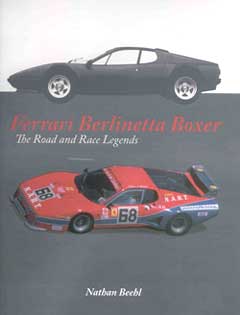
The BB. Or bb. Or Berlinetta Boxer. Or 512BB. Or 365GT4/BB. A tantalizing Ferrari that deserves more press, more history, more of the fame that is normally reserved for it’s front engined cousin, the Daytona. Now comes a book which does all of that and more. Nathan Beehl, a lifelong observer of the marque, has just published “Ferrari Berlinetta Boxer; The Road and Race Legendsâ€.
As author Beehl points out, the Berlinetta Boxer was technically not ever a boxer. We all, or most of us, recognize the Porsche engine and the VW before that to be a ‘boxer’ engine. “A true boxer engine,†Beehl writes, “is one in which the opposite pistons move simultaneously, both in and out at the same time, like clapping hands.†To achieve this effect, each piston has to have its own crankshaft pin. As Beehl notes, Ferrari’s “Boxer†engine used the more common V-12 arrangement of two pistons per journal. Thus, the Ferrari Boxer was really a 180 degree V12.
And with this interesting comment, Beehl begins to chronicle everything you wanted to know about the short lived but rather wild Berlinetta Boxer, of which 2323 were built from 1973- 1984, a remarkably long run through a very turbulent era. The production breakdown of the three models–from Cavallino:
1973-76 365GT4/BB, 387
1976-81 512BB, 929,
1981-84 512/BBi 1007
25 512 BB LMS.
Beehl starts with the engine, as any good Tifoso should do, for it is the heart of the matter. Still, this heart was different, this heart was the first to be placed at the rear of a true Ferrari. (don’t jump, the Dino was not considered a true Ferrari by the factory who built them). The boxer saga started with a 1.5 liter engine developed alongside the 1.5 90 degree V8. The new flat 12 was called the 512 F1, and its best place was second at the 1965 Monaco GP. The new 3 liter formula commenced in 1966 and the project came to a halt. The flat 12 was thought to enable a lower center of gravity and eased repair and maintenance because the ancillaries could be placed on top of the engine block.
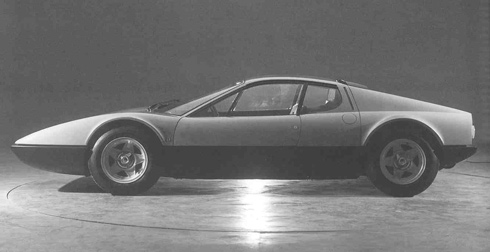 Beehl notes that many of the styling elements from the Daytona were present in the new Pininhfarina Berlinetta Boxer. Couretsy Pininfarina.
Beehl notes that many of the styling elements from the Daytona were present in the new Pininhfarina Berlinetta Boxer. Couretsy Pininfarina.
The flat 12 appeared again as a two liter unit in the 212E Montagna, with which Ferrari dominated the European Mountain Climb Championship in 1969. The 312 which succeeded the 212 was a completely different engine, according to Beehl’s quotes from engineer Mario Forghieri. For the next ten years the 312 and its derivatives powered Ferrari “to three Worlds Driver Championships, four Formula One Manufacturers Championships and won 43 Formula One races.†It’s demise was caused by the down force revolution. “..its low, wide layout took away space need for the all important down force producing underbody venturi sections.†Beehl’s photos and description of the 212/ 312 era are, if not comprehensive, then more than adequate for background. But for all the past history, the 365GT4BB production engine was a Daytona engine laid flat. It worked well, and many of the castings and parts designed for the Daytona V12 were quickly and easily adapted for use on the new Boxer engine. As Beehl says though, that ain’t no bad thing as “there was nothing wrong with the specification and performance of the Daytona engine..†It’s just that it wasn’t a street version of the 312.
And so ends Beehl’s Section 1. Along the way, the journey through the book reveals a large hardbound format 13 ¾ inches high by 9 ¾ inches wide; the binding and jacket are of high quality, as are the 240 black and white and color pages. The page layout and graphics design are good; it is clear, easy on the eyes, and yet artistic. We didn’t catch any typos or spelling errors, but the author’s use of exclamatory words (Wow) and exclamation points is not always to our liking, although they do indicate that Beehl is a very enthusiastic chronicler of the make.
Section 2 consists of an in depth look at the 365GT/4BB, with chapters on the engine, chassis, bodywork, press reaction, and contemporary competition. Sections 3 and 4 look at the BB512 and the BB512i in much the same, but abbreviated, manner. It is not in the Bluemel “Original Ferrari†series category, nor is it meant to be. The chapter covers the cars on a higher level and includes designer’s opinion’s (Chuck Jordan) and “An Owner’s View†by Steve Biagini. An interesting section covers those BB specials made in the 70s and 80s by firms like Koenig, the German company which took the BB horsepower to steadily new heiights, from standard 340-360 to 400, 450, and the twin turbo model rated at 620 hp. Beehl hasn’t forgotten Lorenz & Rankl, Zender or Straman, either. A nice wrap up.
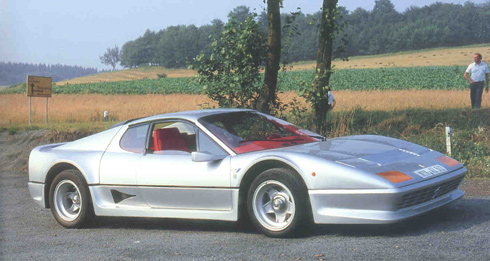 One of the BB specials, this one by Zender, who made a styling kit for the BB. Photo courtesy Marcel Massini.
One of the BB specials, this one by Zender, who made a styling kit for the BB. Photo courtesy Marcel Massini.
Beehl really gets into his stride as he takes on the racing history of the racing Berlinetta Boxers. The LMs today are very active in Vintage racing via the Shell Ferrari Historics in the U. S. and in Europe, and that is as it should be, for despite very little factory involvement, the BBs raced valiantly and effectively for 10 years, from 1975 to 1985. For the first three years, racing Boxers were street cars modified by N.A.R.T. and entered in endurance events. In 1975, results were mixed, no BBs were raced in 1976, and the N.A.R.T. team only did one race with the BB in 1977.
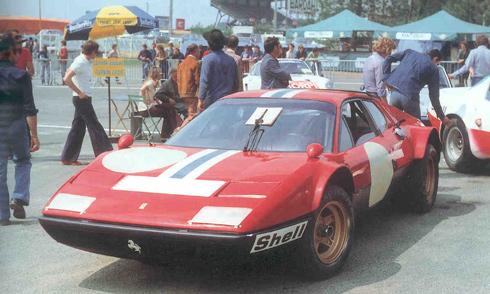 1975: The N.A.R.T. BB, chassis 18095. The modfiications were slight, but the car preceeded the later BB LMs.
1975: The N.A.R.T. BB, chassis 18095. The modfiications were slight, but the car preceeded the later BB LMs.
One would think that the car was already growing long in the tooth but it was really just the beginning. More private teams tried their hand with the mighty BB in 1978, and by the end of the year the Ferrari Assistenza Clienti was actively preparing a rumored nine special BBs for endurance racing. Three showed up at the Daytona 24 hour event in 1979, one under the N.A.R.T. banner and two with Charles Pozzi. All three cars either had tire troubles or were retired due to fear of tire failure at speed. At Le Mans, four cars were entered and one finished 12th overall. In 1980, five cars entered, one finished 10th. The BBs in various guises soldiered on, never placing higher than 5th at Le Mans, but always driven with supreme enthusiasm and great hope. Beehl provides a running commentary, race statistics and places with appropriate serial numbers for the entire ten year run. Good stuff.
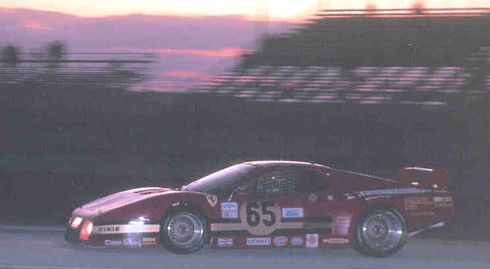 The only BB to lead a major sports car race, chassis 34445 heads into the sunset at Daytona, 1983. Courtesy Daytona Speedway.
The only BB to lead a major sports car race, chassis 34445 heads into the sunset at Daytona, 1983. Courtesy Daytona Speedway.
The race results are followed up with a section tracking all of the individual chassis histories of the Boxers which were raced. That’s the kind of research we like to see. Want to know how many races were entered with chassis 22715? Tis there. 24127? A factory built comp car. And so on.
Beehl wraps it up with a brochure, book and model section, followed by the entire BB registry. No names or current addresses are provided with the registry but it is fascinating and helpful nonetheless.
A must have for Ferrari enthusiasts. And, btw, there is a special edition of the book, along with a CD and many more images also available.
Would not it have been nice had the article included a photo of an unmolested, factory original, BB ? What about carburetotor/injection engines/versions (earlier one with ugly black body panels?)